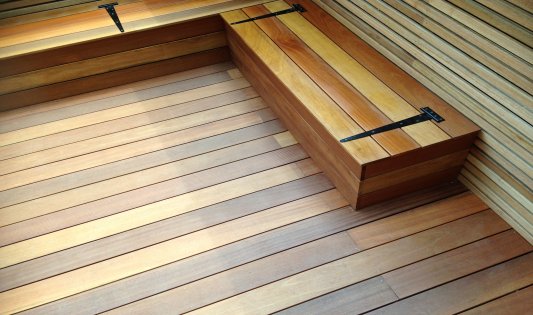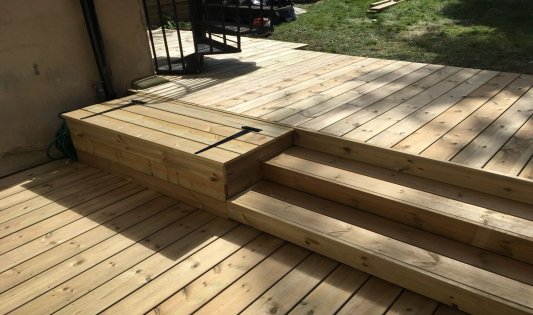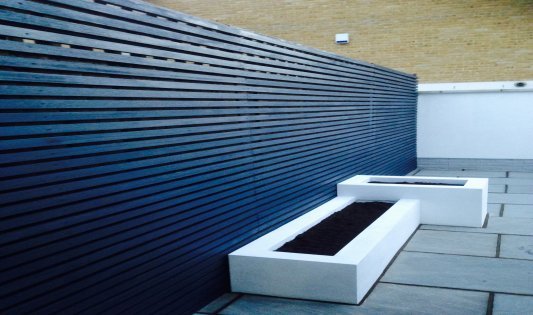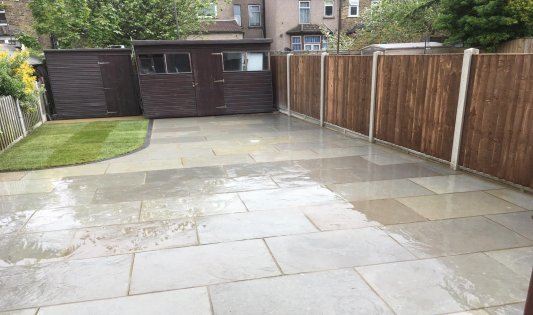Sloped gardens require good planning and there are many things to consider when scoping out your design. Here we talk about some of the things to take into consideration. The first thing that most people think about is getting the garden levelled. Levelling out a sloped garden will take a lot of time and can be costly. It can be expensive due to the labour costs of removing all the extra soil and the waste removal costs for doing this. Also consider how you are removing all of this, is it through the house or do you have side access which does make the process easier. Bear in mind that it could disrupt the foundations of your house if it is a large dig out and give some thought to your fencing as this will be impacted when you level out your garden. A good option for a sloped garden is to create different levels in the garden. Paving or decking with steps to incorporate the slope work well and make a garden look interesting. Alongside the steps you could have retainer beds to bring in some colour or plan some vegetable beds which are very popular in gardens now. Retainer raised sleeper planter beds are a popular choice or you could have rendered retainer beds for a modern look. Also gabions which are wire cages filled with stones make an alternative retaining wall. Building a deck provides a great space for entertaining and is a popular choice when designing a sloped garden as the decking is built above the slope rather than cutting into it. It is more cost effective than building retaining walls into a project. The deck can be raised to incorporate the slope and you have the option of building storage into the space underneath. You can also add lighting to light up the different levels and handrails and spindles for safety. Use the different levels to create different zones in your garden. Plan a seating area directly outside the house leading down to a grass area of either real lawn or artificial grass for play and sunbathing. There are many different options to consider. Think about what works best for you and what you would like to see in your garden. A downhill sloped garden enables you to hide a feature that you would rather not see like a shed. An uphill slope gives you the opportunity to show off a feature you really love like a beautiful pergola. It is very important to consider drainage with a sloped garden so remember to discuss this thoroughly with your landscaper.
Natural Remedies For Removing Weeds From A Patio
Method 1: Pour boiling water on the weeds. Simple boiling water can kill weeds and may even prevent the germination of existing seeds. Generously pour boiling water in all of the cracks in your patio. You may need to repeat this method 2 or 3 times to see significant results. Be careful not to burn yourself! You can repeat this method as often as you like. Be careful as of course, just as boiling water kills weeds, it can also kill our valuable plants if not carried out properly. A kettle with a spout is good to use as the spout allows you to direct the flow of water right on the weeds, while the kettle retains most of the heat. Pour slowly, especially if there is grass nearby or ornamental plants that might be damaged. Method 2: Apply white vinegar to the weeds. Vinegar contains acetic acid, which kills vegetation. Regular white vinegar has a concentration of 5% acid, and pickling vinegar has a 7% concentration. Either of these will work well. You can poke holes in the vinegar cap for a handy way to distribute the “weed killer.” You can apply straight vinegar to weeds or use the following recipe: 1 gallon (3.87 litre) of vinegar (5% or 7% pickling vinegar) + 2 Tbs. (29.5 ml) dish soap + ½ cup (480 ml) salt. This works best when applied during the midday sun. Reapply every 4 to 6 weeks. Method 3 Use salt to kill the weeds. Create a saltwater solution that is 3 parts water to 1 part salt and pour in the patio cracks. Once the weeds begin to die, sprinkle some dry salt in the areas where you see the highest concentration of weeds. If you are not seeing fast enough results, you can increase the concentration of salt in your solution. You can repeat this method every 3 to 6 weeks. Method 4 Sprinkle baking soda in the cracks. Sprinkle baking soda generously all over your patio, and then use a broom to sweep it into cracks. Finish by spraying your patio down with water. You can apply baking soda after a heavy rain and skip the watering. This method works best in the spring or autumn. You can repeat this method every 4 to 6 weeks.
What Is Hardwood Decking
Hardwood decking looks beautiful and is a warm and natural material. Hardwood decking is made from slow growing trees, which are often referred to as broadleaved trees. It has a higher density than softwood, which gives it enhanced durability and strength. Some commonly used hardwoods for decking are Balau, Ipe and Garapa. It is a more expensive option than softwood decking as the wood is more costly and takes more expertise to install. Hardwood decking is more resistant to warping and splitting. It comes in a range of colours and finishes to suit all projects. The wood can be stained to give you a choice of colours to match a theme in your garden. As with all wood products you need to carry out maintenance by cleaning regularly and treating with a decking oil annually to ensure that your decking continues to look great and last a long time. If not treated then it will start to fade to grey. If it does start to fade to grey then use a wood cleaner and colour restorer and then protect it with a wood finish of your choice. Most oils are clear but you can get tinted wood oils. If you would like to discuss a hardwood decking project please get in touch for a free consultation. We cover East London and West Essex.
Looking After Your Garden in a Heatwave
We have some tips here on looking after your garden in a heatwave: Most importantly, water your garden at the right time of day. The best time is first thing in the morning but if this isn’t possible then opt for early evening. Try to avoid watering in the middle of the day. Watering in the morning helps to prevent against your plant leaves being scalded in the hot sun. Potted plants will need even more water and may need to be watered twice a day during extreme heat, once in the morning and once in the evening. Aim the water for the soil around the plants and not the leaves themselves. Any new plants should be given particular attention to help them establish. A water butt is a great way to use water efficiently in your garden so if you don’t have one already it is definitely something to consider. Adding bark or compost to your beds will provide a damp layer of insulation to lock in moisture and help to prevent soil from drying out. If possible move your pots into the shade. You can also buy shade covers for your plants and beds from garden centres. When putting these down take care that they do block the sunlight but that they don’t reduce aeration. Don’t cut your lawn quite as short during the really hot weather as the longer grass casts shadows that help the soil to retain moisture. Keep it around 3”. During a heatwave is not the time to add fertilisers to your lawn as the roots aren’t as able to absorb the nutrients as well so wait until the weather cools down to do this. Leave your soil alone as disturbing it will only get rid of moisture. Finally, look after yourself too. Grab a chair, a cold drink and enjoy the summer in your garden!
What is Softwood Decking
What is softwood decking? Softwood decking is a very popular choice with our clients when installing a decking project. It is beautiful and hardwearing and a more cost-effective choice than hardwood or composite decking. It is made from fast growing evergreen or coniferous trees leading to lower cost levels. The most common softwoods come from evergreen conifers like pine or spruce. The wood fibres are tightly packed together and this structure gives the boards the strength and durability needed to last. All the softwood decking that we install is pressure treated. This means that the wood has gone through a process that uses high pressure to force a solution of water and preservative agents deep into the wood. The decking is then less susceptible to rot and moisture and helps keeps insects at bay. Pressure treated wood is extremely durable and will last much longer than non-treated wood. As with any structure you need to carry out maintenance by cleaning your decking area regularly and treating with a decking oil once or twice a year to ensure that your decking continues to look great and last a long time. A penetrating oil finish is perfect for softwoods. Most oils are clear but you can get tinted wood oils and the decking can be stained to give you a choice of colours to match a garden project. The softwood decking that we install on our projects gives you the choice of a smooth or grooved finish. We work with suppliers who ensure their timber is sourced from sustainable, well-managed forests. If you have any questions or would like to discuss a decking project please get in touch via email office@eastlondonlandscapes.com or call 020 3633 6413.
Latest Client Review
Our latest client review on Google by a happy client in East London. “Chris and his friendly, professional team cleared our lumpy, messy, partially grassed lawn and laid slate to create a beautiful terrace. They were always on time, worked incredibly hard and efficiently, charged a fair price and were a real pleasure to have around. I recommend them without reservation!”
Porcelain Paving
If you are looking for great looking, low maintenance paving then porcelain is a good choice. Porcelain tiles are made in the same way as ceramic tiles but they are pressed and fired at a higher temperature to remove all the moisture. This makes them very strong and resistant to severe temperature changes, frost and cold weather and damage from mould or moss. They are low porous so shouldn’t absorb water or stain. They have a high anti-slip rating and keep their colour well. As porcelain paving is manmade from natural products it is uniform in colour and shape. It is available in a range of designs, sizes and colours enabling lots of flexibility when designing a garden project. It can be used both indoors and outdoors to create kitchen-dining rooms that spill out into the garden and it works in both traditional and contemporary gardens spaces. What also makes porcelain paving appealing is that is extremely low maintenance. A quick jetwash with a mild detergent is all that is needed and it doesn’t require any sealant as its natural strength is built in. Important if you are short on free time.
Raised Flower Beds
Raised flower beds are a popular choice in a garden. They look great, are good for people with mobility issues and for growing plants in different soils. On a personal level we find them really useful for keeping plants away from our dog who loves to pee everywhere in the garden. Another benefit is that they require less watering than containers. The beds can be constructed from railway sleepers, brick or paving slabs. Think about what type would work well within your garden design. With masonry beds you can incorporate curves and shapes into the design. Think about how big you want your beds to be and the placement of them in your garden. Whether they need to be in a sunny or shady spot for your plants. Whether you want only one side of the bed or both sides to be accessible. The width needs to be so that you can reach all areas easily. When considering the height do you want to be able to reach the bed by standing up or gardening by sitting down or kneeling. We include raised beds in many of our garden designs. If you would like to discuss a project please send an email to office@eastlondonlandscapes.com or call 020 3633 6413 to arrange a consultation with one of the team. Our friendly, experienced teams cover East London .
Indian Sandstone Paving
When choosing paving slabs for a garden project Indian Sandstone is very popular and is chosen by many of our clients for their paving projects. It is available in a riven or a smooth sawn surface. Indian Sandstone is a natural, quarried rock that is cut and shaped into paving slabs. As it is a soft rock it is easy to cut and shape to create a curve or a specific design for a patio. It is a good quality paver and comes in a variety of colours and sizes. You can choose to have one size paver for your patio or a combination of the sizes. For maintenance of your paving sweep the patio regularly to remove any debris and wash with soapy water. Try to avoid using any cleaning products that contain acid as this can create rusting on the slabs. If you would like to discuss a paving project please email office@eastlondonlandscapes.com or call 020 3633 6413 to arrange a consultation with one of our friendly team. Our landscaping services cover East London . If you get a moment take a look at our website www.eastlondonlandscapes.com
Composite Decking
Composite decking is becoming a popular choice for decking in a garden project. Its popularity has grown in the past few years and now there are lots of choices of materials, colours and designs. It is fairly low maintenance and comes in a variety of colours meaning that you won’t have to paint or stain it to get the right colour you want for your garden design. Composite decking can get warm in the sun so choosing a lighter colour board will help. It won’t need be sealed either which is another job that can be crossed off the list. To keep it looking its best it will require cleaning by sweeping regularly with a soft brush and washing down with a garden hose. Composite decking is hard wearing and can have a lifespan of 25-30 years. It is a combination of wood and plastic and is sometimes made from recyclable materials. It is stain resistant and won’t splinter or rot. There are non-slip products with textured finishes available which prove popular for a family garden. Taking a look at the costs composite decking is more expensive than wooden decking. The decking is more expensive to buy and the installation is more labour intensive. The joists underneath need to be closer together than for traditional wooden decks. There are additions you can add to your composite deck to complete your look. Railings, post caps and trims create a beautiful finish. If you would like to discuss a decking project please email office@eastlondonlandscapes.com or call 020 3633 6413 to arrange a consultation with one of the team. You can also use our contact form on our website to make an enquiry https://cj-landscapes.co.uk/contact-us/ Our decking services cover East London .








